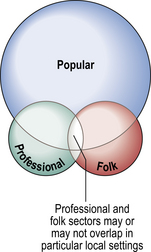Chapter 50 Self-care and the popular sector
People experiencing physical discomfort or emotional distress do not always turn to a doctor for advice and treatment. In all societies there is a range of ways in which people either help themselves or seek help from others. Kleinman (1985) has suggested that health care systems are composed of different sectors or arenas – the popular sector, the folk sector and the professional sector – although they may partly overlap with each other (Fig. 1). In western industrialized societies, the professional sector is predominantly that provided by biomedicine. However, doctors certainly do not see all the illness and disease that occurs in a community. Indeed, they only see what has been called the tip of the iceberg of both symptoms and disease (see pp. 88–89). This means that there is a considerable amount of unmet need in the community, where people may be experiencing health problems that would respond to medical treatment. However, it also means that many people are dealing with a range of both self-limiting and chronic illness themselves, by using self-care (the popular sector) or complementary treatments (the folk sector – see pp. 146–147). We can begin to understand self-care by looking at the popular sector in more detail.




